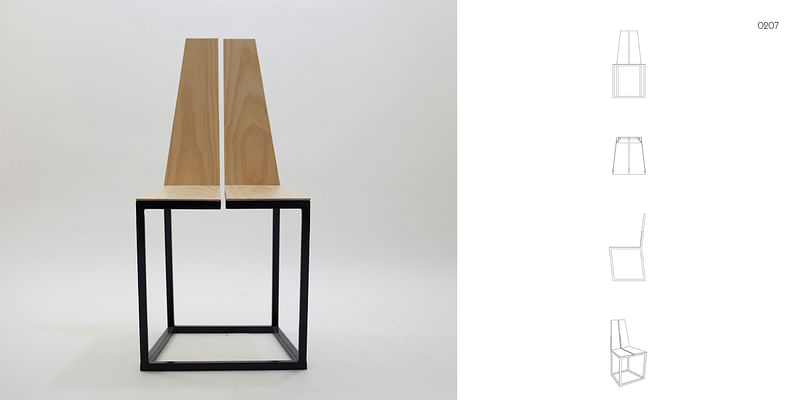eVolo VMODERN winners explore the possibilities of furniture design
By Bustler Editors|
Monday, Dec 21, 2015

Related
The fusion of form and function is the essence of furniture design, and whether we're aware of it or not, furniture has a major impact on the quality of everyday life. In this spirit, eVolo Magazine — the publication that hosts the hugely popular Skyscraper Competition — puts furniture design in the spotlight with their VMODERN Furniture Design Competition.
eVolo launched the ideas competition to create a forum to discuss and debate the future of innovative furniture design. Participants worldwide were able to submit designs in progress, prototypes, and/or concepts.
Out of 233 entries from 34 countries, three winners and 20 Honorable Mentions were announced. Entries were judged on originality, feasibility, function, creativity, and aesthetics.
Check out the winning pieces and some Honorable Mentions below. Would you want to own any of them?
by I-Ting Tsai, Xixi Zheng, Yiru Yun, and Somdatta Majumdar, Daniel Widrig, Soomeen Hahm and Stefan Bassing (tutors, Bartlett School of Architecture, UK) | United Kingdom

Project description: "Fabric chair design is about creating a complex three-dimensional form from a flat sheet, using the traditional art of stitching. This felt composite creates structurally strong, intricate fluid shapes without the help of any mold or formwork which other materials like fiberglass would need.
Fabric in architecture and furniture has long existed but the invention of a composite that makes the fabric the main structural material is unique. Choosing a common off-the-shelf material like fabric and exploring its limits in another dimension was the motive behind this project. This technique of designing the two dimensional pattern which will fold up to the final object is like ‘fabric origami’.
Initially, different types of fabric were studied taking in consideration their elasticity, rigidity, permeability, etc. Initial concept prototypes were created to experiment this technique for smaller objects where double curvatures and the deformations of each pattern of the sheet were studied in detail to understand the forces behind the final forms achieved.
The same process of a machine cutting the felt and letting the fabric stand on its own while the composite is hardened created the chair design. The fabric itself becomes the legs, seat and backrest. The chair was created to show the potential of this design invention, which allows the transition from a 2D surface to a 3D object. Seamless designs are rare due to material size restriction but like the chair made of many components, it can create furniture with no visual seams.
The hardening material had to be very light to not deform the fabric with its weight. After lots of permutations and combinations of applying hardening materials to the fabric and checking different ratios of mixtures we came up with a particular ratio of some special resins. Once the chair is folded to its final form and attached to the scaffolding at minimum places, the resin is applied and the complex organic form freezes. Thus when the scaffolding is removed, the chair is rigid and strong. The fabric is hard as stone in some places and soft in some parts, which is quite a unique feature, which most materials don’t offer. The overall texture still feels like felt, which is soft and warm. The material is breathable in the soft parts letting air to pass through and has a cozy comfortable cushion feel to it.
The Fabric chair challenges our minds, as fabric is not considered to be a strong material able to hold its own form."
2ND PLACE: Simmis Chair
by Studio La Cube | Spain


Project description: "The Simmis Chair plays with its symmetry from different perspectives. There is symmetry between the wood parts, highlighted by a central incision, which is the key element of the chair’s aesthetics. This incision provides lightness, balance, and visual delicacy, which are counteracted by the strength of the material and the cubic form of the lower part. There is also a second symmetry which corresponds to the inclination of the lower cube and the back of the chair – the profiles of these two elements make a symmetric figure between the higher and the lower parts."
3RD PLACE: Helix
by Open Source Workshop. Marcella Del Signore, Giuseppe Morando, Elena Del Signore | Italy, United States


Project description: "Helix is a diffuse furniture system that generates a continuous interior space by adapting simultaneously to any vertical and horizontal surface while defining an immersive spatial atmosphere. Its form recalls a natural system that emerges from the structure beneath. Helix is modular and can be aggregated in different forms following the logic of spatial branching and growth.
The spatial pattern is generated through the repetition of vertical zones (A and B) of the same base module that generates the 3D macro-aggregate surface cut through planes that emphasize the perspectival views of the sequence from the corridor to the interior space. The system morphs the space allowing the viewer to follow the visual continuous trajectory generated by the wrapper (wall + ceiling).
The aggregate surface adapts in response to the specific site conditions and programmatic requirements with each module shaped by scripted rules. It is manufactured through iterative procedures guided by a 5-Axis CNC wire able to carve out the modules from a solid mass of material.
Helix is made of EPS- expanded polystyrene obtained by corn; it is completely recyclable and the manufacturing process helps to reduce CO2 emissions allowing the project to be completely executed through fully sustainable processes. The structure is lightweight yet highly resistant due to the resin finish. Helix investigates the notion of space-atmosphere, adaptability, reuse, and sustainable manufacturing processes."
All images courtesy of eVolo Magazine VMODERN Furniture Design Competition.
Find some Honorable Mentions in the gallery below.









Share
0 Comments
Comment as :